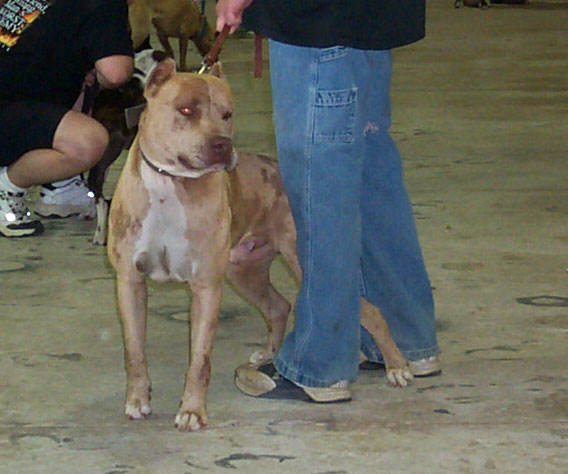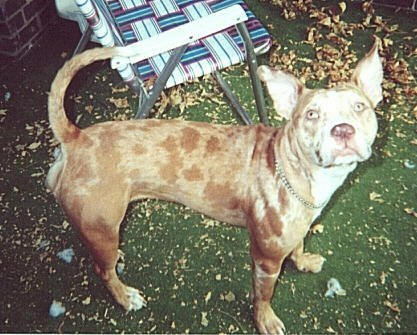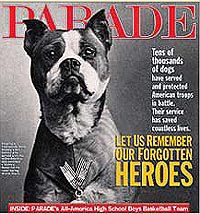Merle Pattern and the APBT

The APBT standard and the recent emergence of the Merle pattern in the breed.
By Scot E. Dowd Ph.D.
The recent appearance of merle patterned APBTs and a couple breeders specializing in the "new" and "rare" color pattern has stirred up a controversy in the APBT community. The general thought among those that have been around the breed for the greatest number of years is that, these new color patterns were brought about by unscrupulous outcrossing to a separate breed such as Catahoula Leopard dogs. Several breeds are known to carry merle as a color pattern but the APBT is not one known to have ever carried this "infected" allele. What is known is that Catahoula Leopard dogs along with pit bulls are often used in the sport of hog catching and it is known that crosses of these breeds have been made in attempts to produce more competitive catch dogs.
The following c omments from the APBT standard committee provide prelude to a brief essay on the merle locus in relation to the APBT
Walt Pasko "I feel the emergence of the merle color pattern in our breed has raised the questions of how it was introduced into our breed and what health problems the merle gene could cause. From all information I've read, I have to recommend that the merle color be made a disqualification in the APBT Breed Standard."
Carol Gaines Stephens "I strongly oppose the color pattern 'merle' in the APBT since it has never been there in the past and has just recently risen it's ugly head with the popularity of the catch dogs in the south. I have spoken to several people from the south that say that they know and do so themselves, cross the APBT with the Louisiana Catahoula Leopard Dog to make a better catch dog. If the gene has never been present in all these decades/centuries then how did it finally come about just recently? I am a firm believer in leaving the standard the way it was originally, but when something surfaces that has no rhyme nor reason, then I think we have to address the matter."
Cheryl Larum "I am in agreement with the other committee members on the merle issue"
Scot E. Dowd " First it should be noted that there are ways that the merle can remain hidden such as within a complete phaeomelanic coat where the merle would not be evident, also there are cryptic merles, however this absolutely would fail to explain the relatively recent appearance of this color pattern in the APBT. I feel that another allele with defined health problems associated with this locus, is not a positive thing for our breed"
The following information is submitted on behalf of the NAPBTA standard committee - Scot E. Dowd
There are two issues of concern with the merle as a color pattern. The first, as mentioned, is that merle pattern in the APBT may have come about through unethical outcrossing to another breed of dog. This practice would then have been followed by falsely registering such a outbred animal either with the ADBA or UKC as a purebred APBT. Such false registration would be termed hanging papers. The other issue is related to the health aspects of the Merle allele. Here I will try to answer the predominant questions that arise regarding the merle allele and the APBT without making a judgment of my own other than that expressed above.
Why is a color or color pattern so important to the stewards of the breed?
The entire process of coloration and color patterns in dogs starts with embryonic development. The specific cells that become melanocytes (pigment producing cells) are derived entirely from the neuronal crest of the embryo. This essentially means that pigment cells are directly produced along with the same cells that give rise to the nervous system. Though not entirely true, it can be assumed that if you have defects in genes associated with color genetics you might also have nervous system defects because both types of cells are derived from the neuronal crest. This provides a logical genetic indicator and explains why it is likely that certain dilute or patterned dogs, such as extreme piebalds, or other types of homozygous dilutes common in the APBT, as well as those that may be carrying the Merle pattern are prone to psychological, neurological and/or immunological problems found in other breeds that carry these alleles.
What is merle?
Merle like other dilution alleles acts to lighten whatever color would otherwise have been expressed. However, with merle the lightening effect is not spread evenly over the coat, but produces patches of undiluted color (dappled pattern) scattered over the dog's body. The merle gene when heterozygous Mm (only one copy of the gene) on an otherwise black dog produces a blue merle which is phenotypically a bluish gray dog that is dappled with full color black spots. A homozygous or MM dog (carrying two copies of the merle gene), often called a double merle or a homozygous merle, will be a mostly white dog (similar to an extreme Piebald). The normal state of the merle locus is dual recessive mm and completely lacks the offending transposon resulting in normal color.
Maybe merle has been in the breed throughout its history and only now is it being noticed?
The response to this question is also genetic in nature. The genetic and phenotypic nature of the Merle locus and the merle allele (M) is such that it would not remain unnoticed in a breed and suddenly appear. It would take crossing to another breed that carries the merle allele for it to be transferred into the breed. The reason it could not remain invisible or hidden is because the Merle allele is expressed with incomplete dominance. This means, if it is within the genome at all, even in a heterozygote (one copy of the gene) state, it is still expressed and evident. The M allele is not found in all breeds; in fact most breeds do not carry it. Finally, this specific transposon cannot arise spontaneously or through mutation as some have claimed.
What are the health problems associated with the merle allele?
The merle allele like a couple other dilution factors when expressed in a homozygous state is correlated to psychological, neurological, and usually immunological issues. Here I will mention a few of the issues. The first are eye development problems that are superficial in nature affecting appearance such as heterochromia iridis (A difference of color between the iris of one eye and the other), thus a dog with one brown and one blue eye has heterochromia iridis. Note that this defect is not necessarily or always indicative of having the merle gene because it can also be found in dogs with extreme piebald or double blue dilution for example. In addition to superficial indicators there are also major effects such as absence of tapetum lucidum. Tapetum lucidum is a reflective substance that lines the back of the dogs eyes. This reflective structure acts like a mirror and reflects light back through the retina, like a satellite dish giving the retina two chances to catch the light. Dogs that lack tapetum licidum have night blindness or reduced ability to see in low light. Another defect is lack of retinal pigment and microphthalmia. Microopthalmia (smaller than normal eye) is described as dogs having prominent third eyelids and seemingly small eyes which appear recessed in the eye socket (enophthalmos). Another problem known as coloboma is actually a physical cleft in a portion of the eye, particularly the iris . In addition to the eyes which are a key indicator of neurological defects, there is also evidence for effects on the ears that result in reduction in auditory sensitivity or complete deafness because the merle color locus exerts epistatic effects on ear development. Excessive white or dilution in a dog of any color can be a warning sign of potential hearing problems. If there is no pigment in the inner ear the dog will be deaf; white ears are more likely to lack inner ear pigment.
More technically, what is the genetic explanation of the merle pattern?
The merle allele is considered to be caused by a transposon or transposable element. A transposon is a piece of DNA that has the potential to actually jump out of, or excise from the gene it has infected (disrupted), during cellular division and genetic DNA replication. This means that while melanocytes are migrating from the neuronal crest during embryonic development the merle transposon can remove itself from the gene in some of the melanocytes when they are derived and produce normal coloration on those parts of the coat to which they migrate. Thus, the merle allele acts to cause eumelanic areas in the coat, to become diluted, but other areas to be fully and intensely pigmented. Such fully colored areas occur in scattered patches throughout the body. The merle locus is autosomal (not carried on one of the sex chromosomes) acting as a dominant mutation (it is expressed in all dogs that carry this gene). It should also be noted that genetically such transposons do not arise spontaneously but must be passed from sire and/or dam to offspring. This means that if the APBT did not carry this allele to begin with, then only through outcrossing to another breed, that does carry this transposon, could it be integrated into the APBT genome.
Thus, we as members of the National American Pit Bull Association are presented with the issue of a dilution pattern that may have been introduced into the breed by unethical conduct. As stewards of the breed we have to choose to continue to honor our current standard and allow this color pattern or to change the standard to reflect that merle is not an acceptable color pattern for the breed.
Citations and additional reading
- Dausch D, Wegner W, Michaelis W, Reetz I. [Eye changes in the merle syndrome in the dog (author's transl)] Albrecht Von Graefes Arch Klin Exp Ophthalmol. 1978 May 2;206(2):135-50.
- Gelatt KN, Powell NG, Huston K. Inheritance of microphthalmia with coloboma in the Australian shepherd dog. Am J Vet Res. 1981 Oct;42(10):1686-90.
- George M. Strain, PhD article published in The Veterinary Journal May 15, 2003,
- Laukner A. [Coat color in dogs. 2: Clinical significance] Tierarztl Prax Ausg K Klientiere Heimtiere. 1998 Apr;26(2):124-8
- O'Sullivan N, Robinson R. Harlequin colour in the Great Dane dog. Genetica. 1988-89;78(3):215-8.
- Sponenberg DP. Inheritance of the harlequin color in Great Dane dogs. J. Hered. 1985 May-Jun;76(3):224-5.
- Sponenberg DP.Germinal reversion of the merle allele in Australian shepherd dogs. J. Hered. 1984 Jan-Feb;75(1):78.
- Sponenberg, D. P. and M. Lynn Lamoreux, 1985: Inheritance of tweed, a modification of merle, in Australian shepherd dogs. Journal of Heredity 76, pp 303-304.
- Sponenberg, D. Philip, 1984: Germinal reversion of the merle allele in Australian shepherd dogs. Journal of Heredity 75, p 78.
- Sponenberg, D. Philip, 1985: Inheritance of the harlequin color in Great Dane dogs. Journal of Heredity 76, pp 224-225.
- Strain GM Aetiology, prevalence and diagnosis of deafness in dogs and cats. Br Vet J. 1996 Jan;152(1):17-36.
- Strain GM. Congenital deafness and its recognition. Vet Clin North Am Small Anim Pract. 1999 Jul;29(4):895-907, vi
- Strain GM. Deafness assessment services by means of the brainstem auditory-evoked response. J Vet Intern Med. 1993 Mar-Apr;7(2):104-5.


